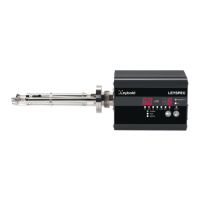300781172_002_C0 - 012/2019 - © Leybold 38
Cautions in operation
accelerated by electric field, impinge upon the diode in the next stage, and generate
new secondary electron groups. As this step is repeated many times, the number
of electrons increases from one to about 100 million when it reaches the dynode of
the last stage. Electrons that reached the last stage are measured by the sensor unit
as current.
Fig. 9.1 Secondary electron multiplier tube (for LEYSPEC view100S/LEYSPEC view200S)
Take the following care in using the secondary electron multiplier (SEM):
Decrease the SEM voltage between -1 and -1.2 kV because gas has been
adsorbed to the dynode surface immediately after pumping down.
If the SEM voltage is increased excessively more than needed, the multiplying
factor may increase, accelerating deterioration, increasing output drift, and
producing noise. These effects lower linearity.
If you are using an analyzer tube that has been vented to atmospheric pressure,
the SEM sensitivity may rise, but this not a problem because it is due to the SEM
surface being cleaned.
The amplification factor of the SEM lowers with operation. It varies with
operating hours, operating atmosphere (gas species, contamination) and others.
The life will be short if the SEM voltage is high and the measuring ion current value
is high.
If you find that you need to measure at the maximum applied voltage, but the
sensitivity is lower than expected and affects the measurement, it is time to replace
the SEM. You can calculate the SEM amplification factor to decide when to replace
the SEM as follows:
SEM amplification factor calculation:
1. In the measurement recipe of the software, decide the mass number to
calculate the SEM amplification factor (for example, use m/z = 18, 28, and so forth,
whose peak is high. If N
2
is available use m/z = 28).
2. In the software control panel, set the detector to SEM and measure the ion
current value of the desired mass number.
3. Perform the same measurement as in (2) by switching detector to FC.

